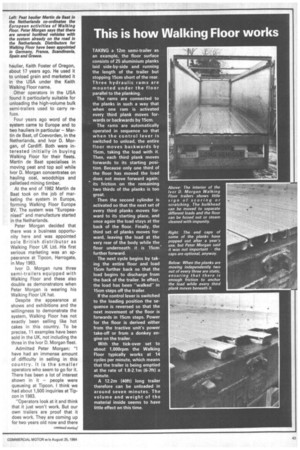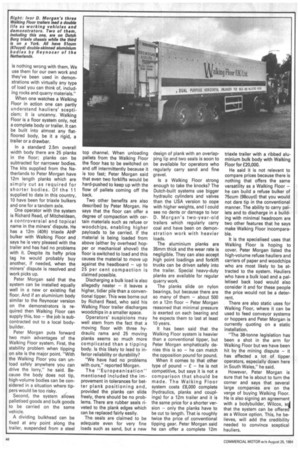Here's a straight tip: unload horizontally
Page 74

Page 75

Page 76

If you've noticed an error in this article please click here to report it so we can fix it.
THE STABILITY of articulated tippers has long been a matter for concern. A much-quoted Health and Safety Executive figure estimates that there are 900 roll-overs a year. But this figure was calculated from work done several years ago. Since the introduction last spring of 38-tanners, one can reasonably expect the problem to be exacerbated; there is more weight up in the air and many more operators are choosing articulated tippers as the economics of a 38-tonne artic score over the conventional 30-ton eightwheeler. Tipping trailer manufacturers do all they can (within the constraints of low unladen weight and cost) to achieve maximum stability with a low centre of gravity and widespread body mounting/rear track. But Peter Morgan says he has the answer to the whole problem — safer tipping and, if necessary, on more difficult sites — and cannot understand why tipper operators have been so reluctant to accept his solution.
Peter Morgan is managing director of Cardiff haulier Ivor D. Morgan and Company and also looks after Walking Floor UK Ltd, a separate company he established to market in the UK the Walking Floor system of vehicle unloading.
This system was devised by an American agricultural haulier, Keith Foster of Oregon, about 17 years ago. He used it to unload grain and marketed it in the USA under the Keith Walking Floor name.
Other operators in the USA found it particularly suitable for unloading the high-volume bulk semi-trailers used to carry refuse.
Four years ago word of the system came to Europe and to two hauliers in particular — Martin de Baat, of Coevorden, in the Netherlands, and Ivor D. Morgan, of Cardiff. Both were interested initially in buying Walking Floor for their fleets. Martin de Baat specialises in moving peat and top soil while Ivor D. Morgan concentrates on hauling coal, woodchips and palletised mining timber.
At the end of 1982 Martin de Baat took on the job of marketing the system in Europe, forming Walking Floor Europe BV. The system was "Europeanised" and manufacture started in the Netherlands.
Peter Morgan decided that there was a business opportunity here and was appointed sole British distributor as Walking Floor UK Ltd. His first serious marketing was an appearance at Tipcon, Harrogate, in May 1983.
Ivor D. Morgan runs three semi-trailers equipped with Walking Floor and these also double as demonstrators when Peter Morgan is wearing his Walking Floor UK hat.
Despite the appearance at shows and exhibitions and the willingness to demonstrate the system, Walking Floor has not exactly been selling like hot cakes in this country. To be precise, 11 examples have been sold in the UK, not including the three in the Ivor D. Morgan fleet.
Admitted Peter Morgan: "I have had an immense amount of difficulty in selling in this country. It is the smaller operators who seem to go for it. There has been a lot of interest shown in it — people were queueing at Tipcon. I think we had about 1,500 inquiries at Tip con in 1983.
"Operators look at it and think that it just won't work. But our own trailers are proof that it does work. They are coming up for two years old now and there is nothing wrong with them. We use them for our own work and they've been used in demonstrations with virtually any type of load you can think of, including rocks and quarry materials."
When one watches a Walking Floor in action one can partly understand hauliers' scepticism; it is uncanny. Walking Floor is a floor system only, not a complete body or trailer. It can be built into almost any flatfloored body, be it a rigid, a trailer or a drawbar.
In a standard 2.5m overall width body there are 25 planks in the floor; planks can be subtracted for narrower bodies. The kits supplied from the Netherlands to Peter Morgan have 12m length planks which are simply cut as required for shorter bodies. Of the 11 supplied to date in this country, 10 have been for triaxle bulkers and one for a tandem axle.
One operator with the system is Richard Read, of Mitcheldean, a controversial and topical name in the miners' dispute. He has a 12m (40ft) triaxle AHP bulker with Walking Floor and says he is very pleased with the trailer and has had no problems with it. Despite its hefty price tag he would probably buy another, if needed, when the miners' dispute is resolved and work picks up.
Peter Morgan said that the system can be installed equally well in a new or existing flat floor. And if an aluminium body similar to the Reynocar version on the demonstrators is required then Walking Floor can supply this, too — the job is subcontracted out to a local bodybuilder.
Peter Morgan puts forward two main advantages of the Walking Floor system. First, the stability problem when tipping on site is the major point. "With the Walking Floor you can unload safely anywhere you can drive the lorry," he said. Because the body does not tip, high-volume bodies can be considered in a situation where tippers would be too risky.
Second, the system allows palletised goods and bulk goods to be carried on the same vehicle.
A dividing bulkhead can be fixed at any point along the trailer, suspended from a steel top channel. When unloading pallets from the Walking Floor the floor has to be switched on and off intermittently because it is too fast; Peter Morgan said that even two forklifts would be hard-pushed to keep up with the flow of pallets coming off the back.
Two other benefits are also described by Peter Morgan. He says that the floor can offer a degree of compaction with certain materials such as refuse or woodchips, enabling higher payloads to be carried. If the material is being loaded from above (either by overhead hopper or mechanical shovel) the floor is switched to load and this causes the material to move up against the headboard — up to 25 per cent compaction is claimed possible.
Discharging a bulk load is also allegedly neater — it leaves a higher, tidier pile than a conventional tipper. This was borne out by Richard Read, who said his Walking Floor trailer discharges woodchips in a smaller space.
Operators' suspicions may well stem from the fact that a moving floor with three hydraulic rams and 25 moving planks seems so much more complicated than a tipping body. Is this likely to lead to inferior reliability or durability?
"We have had no problems with ours," reported Morgan.
The "Europeanisation" mentioned included the improvement in tolerances for better plank positioning and, provided the planks can slide freely, there should be no problems. There are rubber seals riveted to the plank edges which can be replaced fairly easily.
The seals are claimed to be adequate even for very fine loads such as sand, but a new design of plank with an overlapping lip and two seals is soon to be available for operators who regularly carry sand and fine gravel.
Is a Walking Floor strong enough to take the knocks? The Dutch-built systems use bigger hydraulic cylinders and valves than the USA version to cope with higher weights, and I could see no dents or damage to Ivor D. Morgan's two-year-old trailers which regularly carry coal and have been on demonstration work with heavier loads.
The aluminium planks are 35mm thick and the wear rate is negligible. They can also accept .high point loadings and forklift trucks can be driven safely into the trailer. Special heavy-duty planks are available for regular quarry work.
The planks slide on nylon bearings, but because there are so many of them — about 500 on a 12m floor — Peter Morgan reasoned that minimal pressure is exerted on each bearing and he expects them to last at least 10 years.
It has been said that the Walking Floor system is heavier than a conventional tipper, but Peter Morgan emphatically denies this is so — he can match the opposition pound for pound.
When it comes to that other type of pound — — he is not competitive, but says it is not a comparison that should be made. The Walking Floor system costs £8,000 complete (hydraulics, planks and couplings) for a 12m trailer and it is the same price for a shorter version — only the planks have to be cut to length. That is roughly twice the price of conventional tipping gear. Peter Morgan said he can offer a complete 12m triaxle trailer with a ribbed aluminium bulk body with Walking Floor for £20,000.
He said it is not relevant to compare prices because there is nothing that offers the same versatility as a Walking Floor — he can build a refuse bulker of 75cum (98cuyd) that you would not dare tip in the conventional manner. The ability to carry pallets and to discharge in a building with minimal headroom are two other features that he says make Walking Floor incomparable.
It is the specialised uses that Walking Floor is hoping to cover. Peter Morgan listed the high-volume refuse hauliers and carriers of paper and woodchips who are most likely to be attracted to the system. Hauliers who have a bulk load and a palletised back load would also consider it and for these people the price would not be a deterrent.
There are also static uses for Walking Floor, where it can be used to feed conveyor systems or hoppers and Peter Morgan is currently quoting on a static installation.
"The 38-tonne legislation has been a shot in the arm for Walking Floor but we have been hit by the mining dispute — it has affected a lot of tipper operators, especially down here in South Wales," he said.
However, Peter Morgan is sure that he is about to turn the corner and says that several large companies are on the verge of buying Walking Floor. He is also signing an agreement with a bodybuilder, Wilcox, sl that the system can be offere as a Wilcox option. This, he believes, will add the credibility needed to convince sceptical hauliers.












































































































